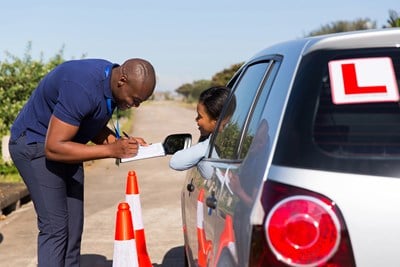Teaching someone to drive can be nerve-wracking, but everyone has to learn somehow. Keeping calm is important—freaking out will only make the student anxious. So to help avoid any issues, here are 10 tips for teaching a teenage boy (or anyone) to drive.
- Stash the cell phone in the glove compartment
The biggest distraction to drivers are cell phones. On average 3,000 teenagers die every year because of texting while driving. Educate your student early that he should not be on the phone while driving. Instruct him to place his phone in the glove compartment or center console before putting the vehicle into “drive.” Make this a habit every time you get in the car with him. - Teach hazard recognition and judgment
Young drivers are taught to keep their hands at “10 and 2” and how to parallel park, but other good lessons are how to recognize hazards and make judgment calls. As an experienced driver, you know the signs of a hazard. Hand down this knowledge to your learning driver. If someone is about to drive into his lane, tell him what you notice and point out the signs. To teach good judgment, purposefully instruct him how to make left turns across oncoming traffic, as well as how to merge on and off highways at high speeds. - Purposefully drive in bad weather
Driving in bad weather isn’t fun for anyone, but a learning driver will become even more nervous if it’s his first time. To avoid this anxiety, purposefully drive in bad weather—snow, heavy rain, etc. Having you in the vehicle will help calm the student, and you’ll be able to give him tips on maneuvering obstacles, driving at a safe speed, and proceeding if a path isn’t clear. - Consider defensive driving courses
It’s been proven that defensive driving courses reduce motor vehicle accidents and improve the safety of drivers on the roads. Usually it’s a single Saturday class for a few hours. If you are having trouble finding one in your area, most police stations know of these courses and are more than happy to share them with you. - Plan your route ahead of time
Simply getting in the car and driving around aimlessly can lead to a lack of motivation and a slow learning rate for the student. Plan where you’re going ahead of time to avoid any issues and decrease the amount of stress on the driver. Planning a route can be as simple as using Google Maps or as complex as driving the route ahead of time. - Critique carefully
Informing your novice driver what he does wrong is important, but you should comment on more than just the negative. Compliment the driver on what he’s doing right. An occasional slip-up should be expected, but as long as it isn’t illegal and doesn’t compromise the safety of the driver, consider letting it go. And avoid vague terms such as “gently” or “slowly.” Instead, be precise and state “Drive at 30 miles per hour.” - Fishtail on purpose
This should only be done when it’s safe for you and the driver. While driving, purposefully tell the driver to stop quickly and turn abruptly while accelerating. These maneuvers will cause the weight of the vehicle to shift forward, and the car will fishtail. It happens at some point to all drivers and can cause an accident if the driver doesn’t know what to do. Tell him to tap the brakes and slowly turn away from the direction of the skid. These moves will help him retain control. - Help the student find “exit points”
Other drivers make mistakes on the road. It's just a fact of life. A new driver may not know what to do when someone suddenly veers into his lane. Teach him how to spot “exit points.” Driving into the grass is preferable to a collision. - Teach him that hitting an animal is better than jerking the wheel
As hard as it is, teach the driver to hit an animal rather than jerking the wheel. This is for two reasons. One, the driver is less likely to sustain personal injuries by hitting the animal than by trying to suddenly dodge it. Two, insurance companies will cover the vehicle damage if you hit the animal rather than if you veer off the road and hit something else. Learning this will take practice because swerving to avoid an animal is a knee-jerk reaction, but it’s an important lesson. - Consider hiring a professional
If it seems like the learning driver needs extra assistance, consider hiring a professional. There are several driving courses for teenagers and young adults that perfect driving techniques. The instructors have experience teaching good habits, discouraging bad habits, and spotting issues that may arise while driving.



